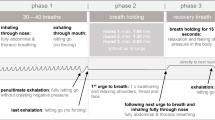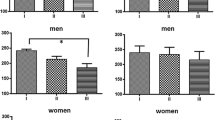Abstract
The purpose of the investigation was to study group dynamics of seasonal changes in the autonomic nervous and cardiovascular functions in apparently healthy men who occupationally deal with frequent stressful situations (field personnel and firefighters of the Almaty Emergency Management Department (EMD), Emergency Ministry of the Republic of Kazakhstan (EM RK). The investigation was conducted according to the program of parallel medical and environmental investigations within the framework of the Mars-500 project in the city of Almaty, based on the support from the Kazakh National Medical University with respect to terminology based on using the prenosological approach which allows one to assess states in between the norm and pathology. Results of the year-long investigation demonstrated seasonal variations in the functional state of body with identification of groups up to prenosological ones, which could be associated with specific occupational factors and arduous duty, as it follows from the Almaty EMD operational summary (autonomic balance shifting toward prevalence of the sympathetic control during spring and summer arduous duties, and toward the parasympathetic control under quiet duty conditions during wintertime). These observations testify to the importance of dynamic health monitoring concerning apparently healthy people who are occupationally exposed to chronic psycho-emotional strain for prenosological diagnosis and timely preventive intervention.
Similar content being viewed by others
References
Baevskii, R.M., Problem of assessing and predicting the functional state of body and its development in cosmic medicine, Usp. Fiziol. Nauk, 2006, vol. 37, no. 3, p. 13.
Baevskii, R.M., Ivanov, G.G., Chireikin, L.V., et al., Analysis of cardiac rhythm variability with the use of different electrocardiographic systems (methodological recommendations), Vestn. Aritmol., 2001, vol. 24, p. 69.
Baevskii, R.M. and Berseneva, A.P., Use of principles of prenosological diagnosis for assessing the functional state of the body under stress conditions as exemplified by bus drivers, Human Physiol., 2009, vol. 35, no. 1, p. 34.
Baevskii, R.M. and Berseneva, A.P., Relation between parameters of cardiac rhythm variability and parameters of ECG dispersive mapping for different functional states of body, in Mater. IX kongr. Ros. obshchestva kholterovskogo monitorirovaniya i neinvazivnoi elektrofiziologii (Proc. IX Congress of the Russian Society of Holter Monitoring and Non-invasive Electrophysiology), Suzdal, 2008, p. 31.
Bigunets, V.D., Physiological and hygienic characteristic of professional activity of rescuers of the Ministry of Emergency of Russia, Cand. Sci. (Med.) Dissertation, St. Petersburg, 2004.
Grigor’ev, A.I. and Baevskii, R.M., Kontseptsiya zdorov’ya i kosmicheskaya meditsina (Health Concept and Space Medicine), Moscow, 2007.
Kozyreva, L.V. Functional state of autonomic nervous system in the rescuers of the Ministry of Emergency of Russia, Extended Abstract of Cand. Sci. (Med.) Dissertation, St. Petersburg, 2004.
Baevskii, R.M. and Chernikova, A.G., On the problem of physiological standard: mathematical model for functional states based on analysis of cardiac rhythm variability, Aviakosm. Ekol. Med., 2002, no. 6, p. 11.
Orlov, O.I., Baevskii, R.M., Pugachev, V.I., et al., Telemedical aspects of risk assessment for disease development in apparently healthy people. Preliminary results of long-term medical and environmental research, Klin. Inform. Telemed., 2011, vol. 7, no. 8, p. 50.
Takada, M., Ebara, T., and Kamijiama, M., Heart rate variability assessment in Japanese workers recovered from depressive disorders resulting from job stress: measurements in the workplace, Int. Arch. Occup. Environ. Health, 2010, vol. 83, no. 5, p. 521.
Malpas, S., Sympathetic nervous system overactivity and its role in the development of cardiovascular disease, Physiol. Rev., 2010, vol. 90, p. 513.
Heart rate variability: Standards of measurement, physiological interpretation and clinical use, Circulation, 1996, vol. 93, p. 1043.
Author information
Authors and Affiliations
Corresponding author
Additional information
Original Russian Text © A.K. Eshmanova, A.A. Akanov, A.M. Kiyabaev, 2013, published in Aviakosmicheskaya i Ekologicheskaya Meditsina, 2013, Vol. 47, No. 6, pp. 34–39.
Rights and permissions
About this article
Cite this article
Eshmanova, A.K., Akanov, A.A. & Kiyabaev, A.M. Cardiovascular function dynamics in healthy Kazakhstan residents participating medical and environmental investigations who work under extreme conditions (Emergency Ministry personnel). Hum Physiol 41, 796–801 (2015). https://doi.org/10.1134/S036211971507004X
Received:
Published:
Issue Date:
DOI: https://doi.org/10.1134/S036211971507004X




